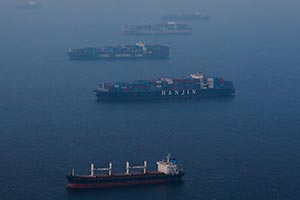Hanjin Ships Get Stranded in High Seas, Roiling Supply Chain

Hanjin Shipping Co.’s vessels are getting stranded at sea after the South Korean container mover filed for court protection, roiling the supply chain of televisions and consumer goods ahead of the holiday season.
LG Electronics Inc. is trying to find new carriers for its goods, the world’s second-largest manufacturer of televisions said. Shipments through Hanjin account for 15% to 20% of LG’s deliveries to America. Hyundai Merchant Marine Co., the nation’s second-biggest container line, stepped in, saying it plans to add 13 more vessels to ease the squeeze.
Woes at Hanjin Shipping, South Korea’s largest sea container shipping firm and the world’s seventh-biggest with a 2.9% market share, are derailing the supply chains of companies that need to send goods well in advance of the year’s biggest shopping season as the Thanksgiving and Christmas holidays approach. TVs, cars and sneakers sail about 10 days to reach Los Angeles from Asia, but they could take as long as 30 days to reach Rotterdam. Hanjin Shipping owns 59 of the 132 container and bulk ships in its fleet.
RELATED: Hanjin Shipping files for court protection after revamp rejected
“Ports will not have these vessels because they are worried port and other fees won’t be paid,” said Rahul Kapoor, a Singapore-based director at Drewry Maritime Services Pvt. “This is going to play out for the next few weeks.”
On Sept. 1, the Seoul Central District Court accepted the receivership application Hanjin made Aug. 31. A revival plan must be submitted by Nov. 25, according to the court, which also named company CEO Seok Tae Soo as the manager.
Hanjin ranks No. 23 on the Transport Topics Top 50 list of the largest global freight carriers.
Three of Hanjin’s vessels were stuck off the Los Angeles-Long Beach port complex, while one was stranded near the Port of Prince Rupert in British Columbia, Canada. Workers in the Korean port of Busan refused to work on a ship because the company hasn’t paid dues, forcing the cancellation of a berthing. Another was seized in Singapore on Aug. 29.
About 10 more were impounded at Chinese ports, including Tianjin and Shanghai, for failing to pay service providers, the Korea International Trade Association said.
"The company is internally looking into measures in case our cargo gets stranded while it’s being shipped," LG said in the e-mail in a response to a Bloomberg News query.
Hanjin Shipping’s local-currency notes due June 2017 tumbled to 13.4% of face value in Seoul on Sept. 1, according to Korea Exchange prices, after fetching 90% in March. Trading in its shares were suspended after a 24% plunge Aug. 30 to their lowest level since December 2009.
About 70% of South Korea’s overseas shipments are through sea, of which Hanjin Shipping accounts for about 6%, according to Cheong Seung Il, a trade ministry official. While the government doesn’t expect a large effect on exports, there could still be some issues with machinery and textiles shipped via Hanjin, he said.
“Some of their clients would be worried about getting their cargo if the vessels can’t enter ports,” said Shin Ji Yoon, an analyst at KTB Investment & Securities Co. in Seoul.
Hyundai Merchant plans to add four vessels to the United States, starting Sept. 9, and nine on Europe routes later this month. Japanese shipping companies Kawasaki Kisen Kaisha Ltd. and Nippon Yusen KK said they are working to limit delays to clients’ cargo.
Kawasaki Kisen, which is in the same shipping alliance as Hanjin Shipping, is studying the effects of the Korean company’s filing, Masaya Futakuchi, a company spokesman, said by phone. Nippon Yusen isn’t part of the same alliance but has a business partnership with Hanjin, spokesman Brandon Kitamura said.
Freight charges from South Korea surged about 50% after Hanjin Shipping filed for court receivership Aug. 31, Korea Economic Daily reported, citing shipping industry officials it didn’t identify. The fees on Hanjin’s main shipping route between Busan and Los Angeles have jumped 55% to $1,700 per 40-foot equivalent box from $1,100, it said.
Hanjin Shipping filed for court protection Aug. 31 after lenders rejected its restructuring proposal, scuttling revival efforts by the firm that’s been trying to reschedule debt under a voluntary creditor-led program since May. Hanjin’s woes reflect those of an industry that’s been operating at a loss since the end of 2015, and the firm is set to lose about $5 billion this year amid an oversupply of vessels, according to Drewry.
The possibility of a liquidation can’t be ruled out, though a court will determine the fate of Hanjin Shipping, said Yim Jong Yong, chairman of South Korea’s Financial Services Commission, in comments e-mailed by the regulator.
Hanjin Shipping is part of Hanjin Group, which also owns Korean Air Lines Co., the world’s third-largest cargo airline. Korean Air loaned funds to Hanjin Shipping and bought shares in the container line in 2014 to become the biggest shareholder with 33%. The group, which also counts airport services, logistics and mineral water among its businesses, is headed by Chairman Cho Yang Ho.

